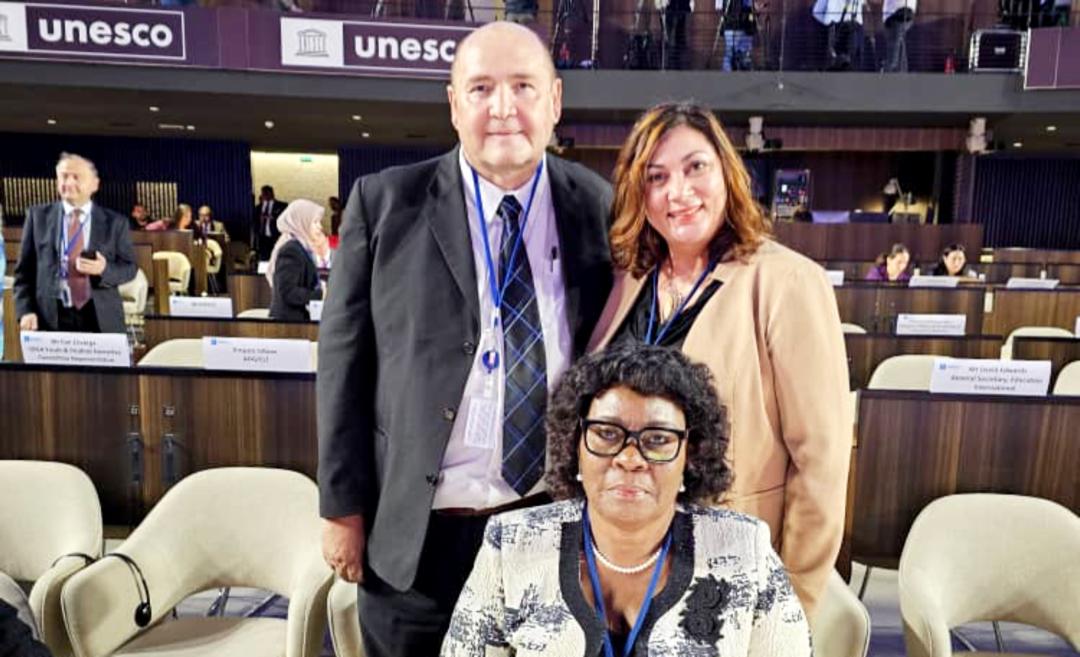In Namibia, southern Africa’s driest country, where sewerage connections reach just 35% of citizens, dry toilets are vital to providing sanitation.
Dry toilets do not require water or chemicals to move waste along. Instead, excrement drops into a tank or bag that must be emptied and cleaned.
The lifetime costs of dry toilets are lower than that of flush toilets as they save on water, and some even produce fertiliser from the dried waste. But they do require more work. There’s no water seal to protect from the smell, so daily cleaning and good ventilation is vital. The tank must be regularly emptied. And if the toilet is a pit latrine, then one must dig another hole and move the pot before the next use.
In 2012, after visiting Namibia, the UN’s special rapporteur on the human right to safe drinking water and sanitation, Catarina de Albuquerque, outlined that public participation “in the design, implementation and monitoring” of toilet initiatives would be indispensable in providing the country with sanitation.
She also warned that the benefits of investing in sanitation would be lost if the government failed to give equal attention to “hygiene promotion and awareness raising on the benefits of safe sanitation”.
The government’s 2008 Water Supply and Sanitation Policy outlined that improving sanitation would be achieved by “community involvement and participation”. Yet, it appears it has not followed its own guidance.
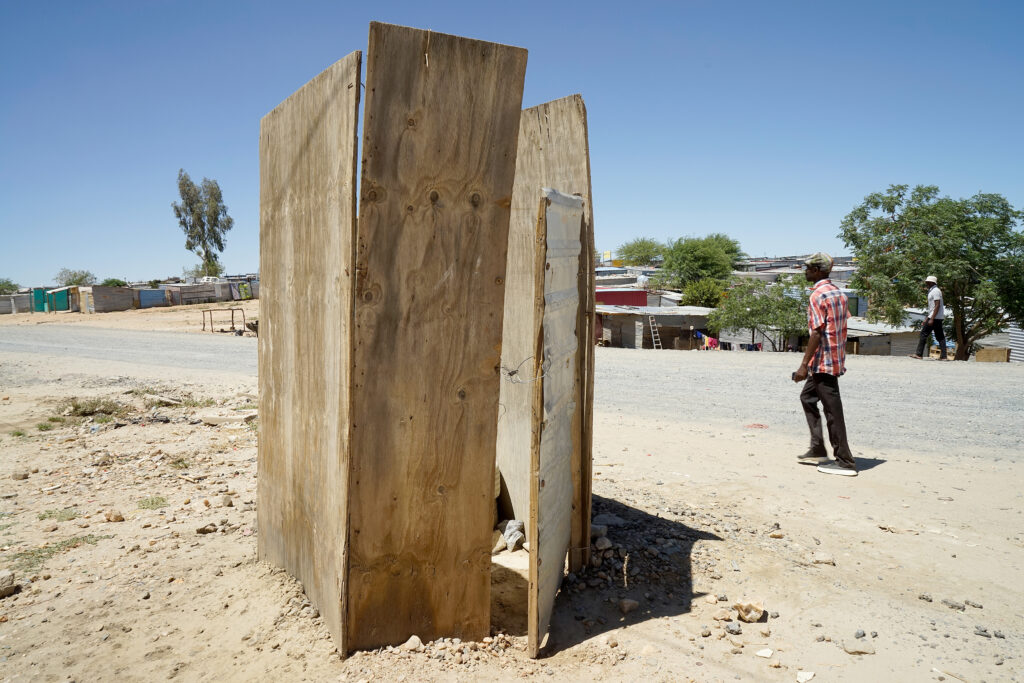
In 2012, the government constructed 10 000 dry Ecosan toilets across five northern regions at a cost of N$181,5 million, but many are no longer usable because residents say they were not provided with instruction, promotion, cleaning or maintenance guidance upon installation.
In 2014, many beneficiaries of a scheme that aimed to build 6 500 pit latrines across the country returned to the bush to defecate. Residents of the Coblenz and Okondjatu villages in central Namibia complained about the stench and their inability to keep the toilets in good condition.
The latest draft of Namibia’s 2022-2027 National Sanitation and Hygiene Strategy admitted that “[u]ser involvement in the choice of sanitation systems and their construction, operation and maintenance [was] limited… [leading] to sanitation facilities not being used, operated or maintained properly”.
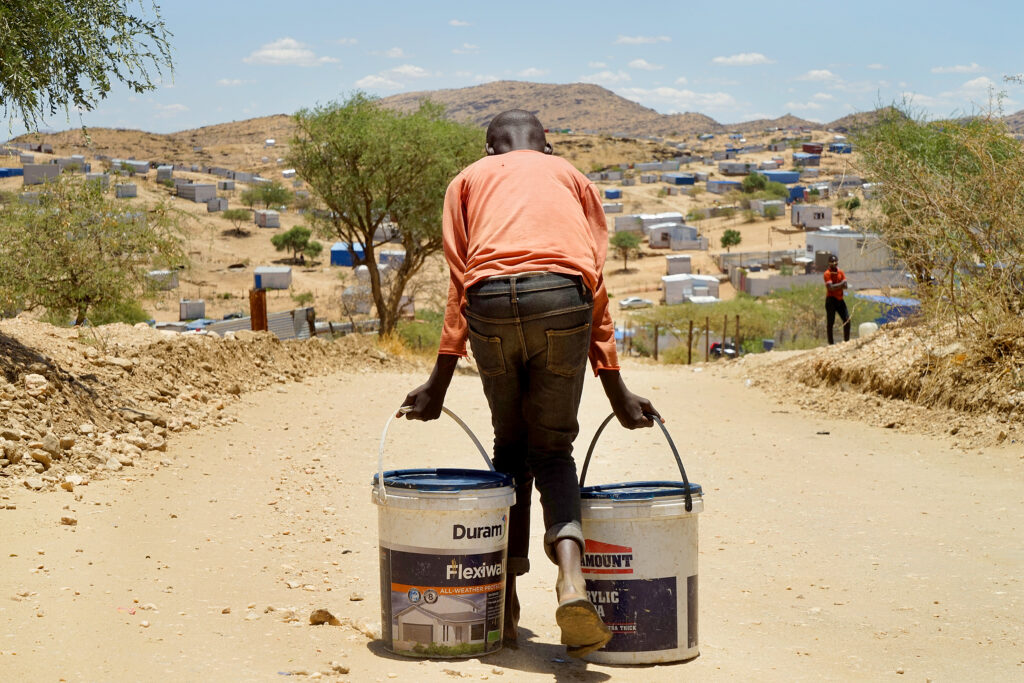
It was the duty of the Ministry of Agriculture, Water and Land Reform (MAWLR) to organise the training of communities on operation and maintenance, according to the government’s 2010-2015 National Sanitation and Hygiene Strategy.
The Ministry of Health and Social Services (MoHSS), meanwhile, was responsible for conducting “hygiene education in rural areas and informal settlements”. But this doesn’t appear to have happened.
In fact, according to the latest draft of Namibia’s 2022-2027 National Sanitation and Hygiene Strategy, MAWLR and the Ministry of Urban and Rural Development (MURD) alone built 20 230 sanitation facilities between 2009 and 2019, yet “no community involvement and participation or sanitation hygiene promotion activities were incorporated”.
During those 10 years, open defecation dropped by just 2,7% nationwide, while sanitation levels in urban areas declined more meaningfully.
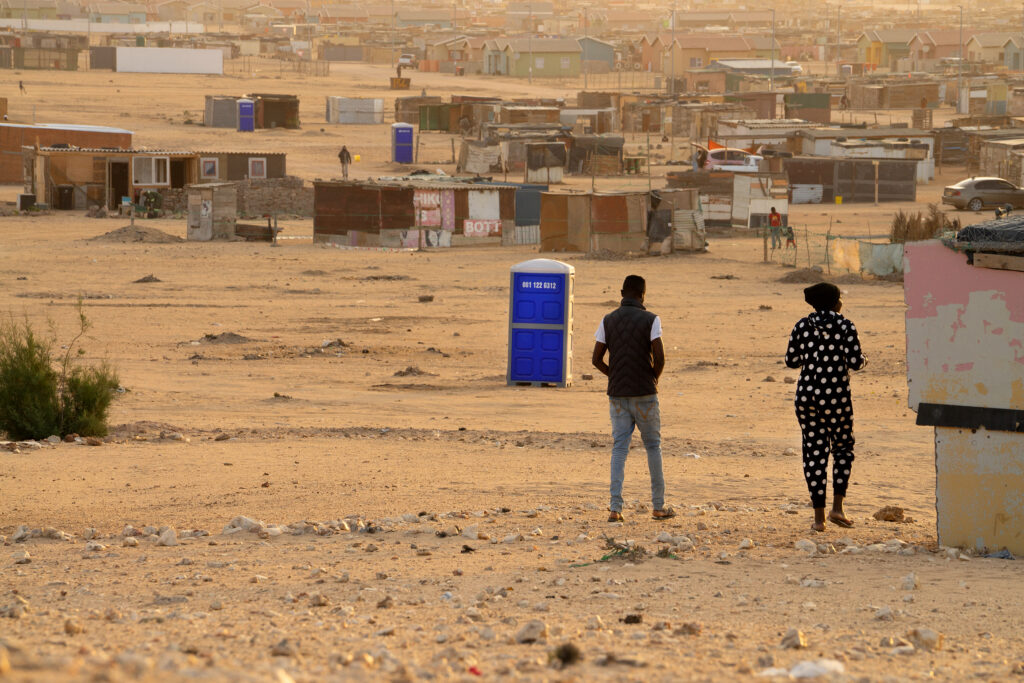
CCIJ asked deputy executive director of water affairs Elijah Ngurare why Namibia failed to engage communities in training and operation or to run a national campaign promoting hygiene.
“Sanitation challenges have been acknowledged and the government has now decided to scale up the process… construction, maintenance and rehabilitation are going to be the norm. This includes both rural urban and rural sanitation,” Ngurare said.
But the government has made implementing such strategies as complicated as possible. Rather than centralising responsibility for improving sanitation, seven ministries, regional councils and local authorities have each been tasked with its delivery: MAWLR, MoHSS, MURD, the Ministry of Education, Arts and Culture, the Ministry of Environment, Forestry and Tourism (MEFT) and the Ministry of Gender Equality, Poverty Eradication and Social Welfare each have funding for sanitation in their budgets.
Meanwhile, local authorities – partly funded by the central government – are responsible for providing sanitation in urban areas, including informal settlements, and the Ministry of Works and Transport (MWT) is responsible for developing new and managing existing wet sanitation systems.
This division of duties and funding makes it especially difficult to monitor and track investment in sanitation.
The latest version of Namibia’s 2022-2027 Sanitation and Hygiene Strategy acknowledges that the government and local authorities “do not have a clear budget line for sanitation… As a result, the sanitation budget is… difficult to track”.
Mathew Shuuya of Unicef said this contributed to poor coordination of the sanitation sector.
The consequences of insufficient governance are evident. Damaged, disused and derelict government toilets can be found across the country. Often, they are filthy beyond use, blocked by newspapers or filled with excrement, and a considerable number no longer function.
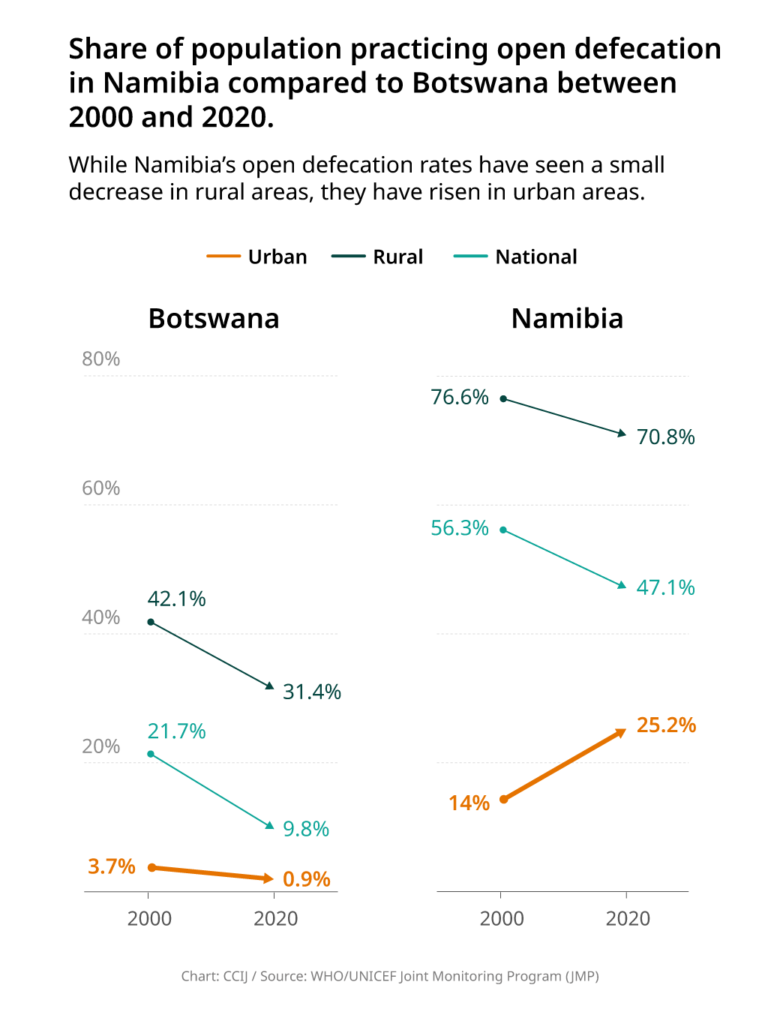
CUTTING CORNERS
At a time when sanitation is in desperate need of a dedicated and coordinated approach, those in the private sector say the government has complicated efforts to provide more sustainable options.
Omuramba Impact Investing is the sole distributor of a dry toilet called the Enviro Loo. Unlike the ventilated pit latrines preferred by the government, executive director Eline van der Linden says the Enviro Loo reduces odour and prevents groundwater pollution.
Crucially, she also offers user and maintenance training upon installation, including refresher courses. But the technology and training come at a higher price tag.
In 2010, German development agency Gesellschaft für Internationale Zusammenarbeit (GIZ) supported the Omaruru Basin Management Committee (OmBMC) in central Namibia by providing 140 informal settlement residents with 21 dry Otji toilets, designed by Namibian NGO Clay House Project (CHP).
CHP staff built the toilets while training local labourers, and nurtured a sense of ownership as beneficiaries made a small financial contribution and assisted in painting and digging. Each toilet was equipped with instructions and handwashing facilities, and CHP also conducted an awareness-raising campaign to promote the use of toilets which remained in use and well maintained more than 18 months later.
Windhoek Rural constituency councillor and Popular Democratic Movement member Petrus Adams says Groot Aub residents don’t always have enough water to use flush their toilets.
In a country where almost a third of citizens worry about where their next meal will come from, many can scarcely afford the additional costs of a flush toilet.
“Wet sanitation risks making unaffordable water even more unaffordable,” said De Alburquerque.
Health minister Kalumbi Shangula acknowledged that inadequate access to sanitation was leading to sickness and infection, while the risk of disease and pollution also threatens tourism and agricultural industries.
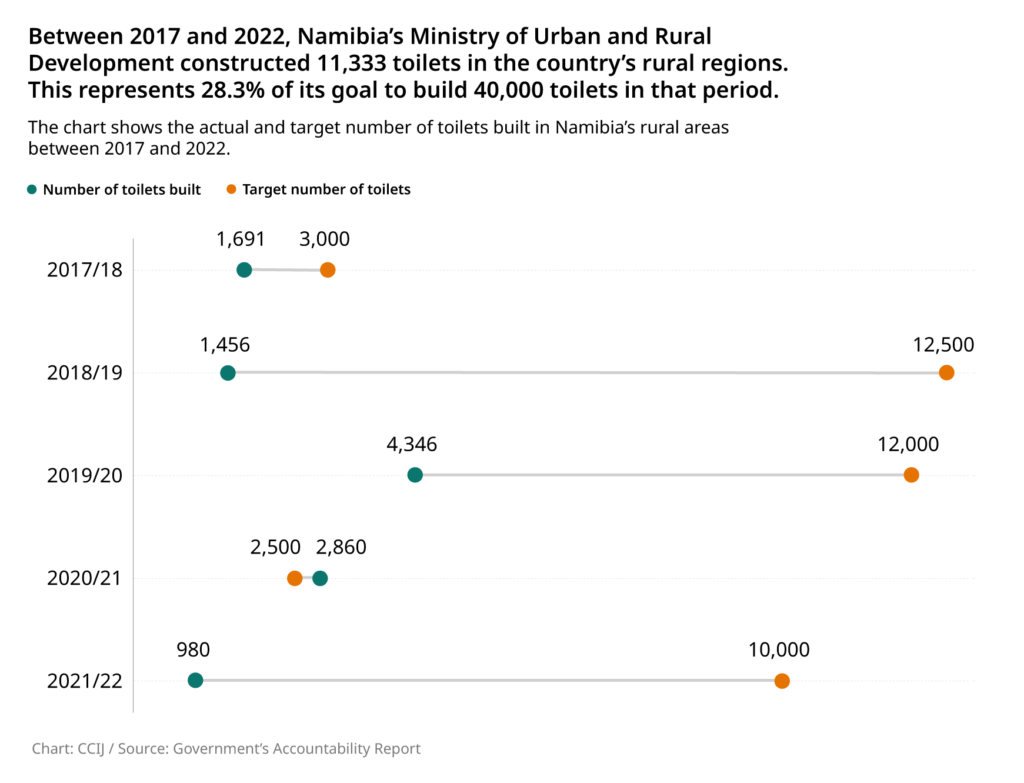
A WEAK DEFENCE
By the government’s own admission, sanitation has stalled in recent years, with various ministries tasked with improving sanitation failing to prioritise the sector.
MURD, for example, has failed to hit its toilet targets in four of the last five years. In 2021, the ministry promised to construct 10 000 new toilets in rural areas, but built only 980 before claiming the original target was “erroneously indicated” and that 1 000 was the real target.
In explaining the failure in meeting even this target, the ministry said “late submission of activity plans and accountability reports from the regions result[ed] in late approval of budgets”.
The works ministry, charged with the coordination of government sanitation services, admitted via email to CCIJ that challenges in improving sanitation included “poor sanitation practices and the non-involvement of communities,” but said limited access to water and finance remained a hindrance.
But vast sums have been allocated to the ministries responsible for sanitation.
Ngurare, however, admitted that “most funding earmarked for water and sanitation in the last couple of years had unfortunately been redirected to the Neckartal Dam”.
Shangula also blamed a lack of funds, arguing low tax revenues prevented Namibia from prioritising sanitation. And while Namibia may have a narrow tax base, according to the World Bank, it generates more tax revenue per capita than Botswana, Lesotho and almost as much as Zambia, three countries in southern Africa with better sanitation coverage.
While Botswana also struggles with poor informal settlements, sparsely populated rural areas, water scarcity and an arid climate, according to the World Health Organisation and Unicef’s Joint Monitoring Programme, 80% of its citizens have access to at least basic sanitation, more than double that of Namibia.
Eleven years ago, De Alburquerque said Namibia’s sanitation deficit was not a result of a lack of finances, but a “lack of a common vision, prioritisation” and an “absence of effective coordination among the different ministries and between central and local government”.
In 2023, these are still the biggest obstacles to improving sanitation.
But where the government has fallen short in reaching its stated sanitation goals, others are now stepping in. However, urbanisation and climate change are pushing back, escalating a crisis that threatens more death, disease and contamination in the next decade.
*This report was produced by the Centre for Collaborative Investigative Journalism (CCIJ), a non-profit organisation that brings together investigative reporters, visual storytellers and data scientists to investigate key global issues affecting communities. This report was supported by the Pulitzer Centre.
*Part three of CCIJ’s investigation into Namibia’s sanitation crisis will be published tomorrow.
Stay informed with The Namibian – your source for credible journalism. Get in-depth reporting and opinions for
only N$85 a month. Invest in journalism, invest in democracy –
Subscribe Now!




